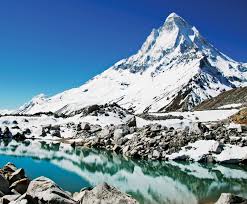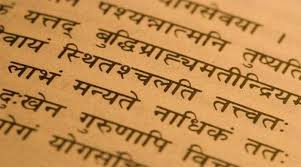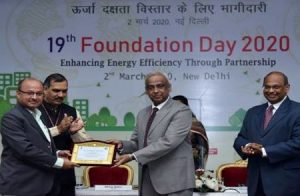Table of Contents
Daily Current Affairs for Government Exams:
Today Current Affairs: 3rd March 2020 for UPSC IAS exams, State PSC exams, SSC CGL, State SSC, RRB, Railways, Banking Exam & IBPS, etc
Contents:
- GoI nominates 2 sites to be included in the World Heritage Sites List.
- Various schemes have been launched to preserve and promote languages, folk dance, Art and culture of tribals.
- The concentration of Black Carbon on Gangotri Glacier:.
- F8 developers conference:
- Defense Expenditure as a Part of GDP.
- The Central Sanskrit Universities Bill, 2019 in Rajya Sabha:.
- 19th foundation day, Bureau of Energy Efficiency (BEE):
- In-flight WiFi services to passengers:
- Flow Diverter Stents Technology for the treatment of Aneurysms of brain
- Suposhit Maa Abhiyan:
- 8th Foundation Day of the Land Ports Authority of India (LPAI) has been celebrated in New Delhi.
- State funding of elections:
- Other important current affairs
1. Government of India nominates 2 sites to be included in the World Heritage Sites List:
Recently, the Minister of State of Culture and Tourism has informed Lok Sabha that India has submitted two nomination dossiers namely ‘Dholavira: A Harappan City’ and ‘Monuments and Forts of Deccan Sultanate’ for inclusion in the World Heritage List for the year 2020.
Dholavira: A Harappan City:

The City of Dholavira located in Khadir island of the Rann of Kutch (Gujarat) belonged to the mature Harappan phase.
- It was excavated by R.S Bisht in 1985.
- It demonstrates a highly organized system of town planning with perfected proportions, street-pattern and an efficient water conservation system that supported life for more than 1200 years (3000 BCE to 1800 BCE) against harsh hot arid climate.
- The water conservation methods of Dholavira are unique and measures as one of the most efficient systems of the ancient world.
- The presence of a three-tier zonation comprising of a distinct upper (citadel, bailey) and middle (having a distinct street-pattern, large scale enclosure, and a ceremonial ground) towns enclosed by a lower town (with narrower streets, smaller enclosures, and industrial area) – distinguishes the city of Dholavira from other metropolises of the Indus Valley Civilisation.
Monuments and Forts of Deccan Sultanate:

The ‘Monuments of the Deccan Sultanate’ demonstrates the convergence of national and international styles of Islamic architecture and their intersections with the prevalent Hindu architecture of the period southern Indian in present-day Karnataka and Andhra Pradesh,
- It comprises of four components namely,
- Bahmani Monuments at Gulbarga, Karnataka:
It primarily comprises the Gulbarga Fort with the Great Mosque in the Fort, Jami Masjid and the Haft Gumbad complex with seven tombs. Gulbarga was the first capital of the Bahmani dynasty. - Bahmani and Barid Shahi Monuments at Bidar, Karnataka:
It includes monuments at Bidar dating from the late 15th to the early 16th centuries comprise of the Bidar Fort, the Madrasa Mahmud Gawan, the Bahamani tombs at Ashtur and the Barid Shahi tombs.
The significant feature of Bidar is the sophisticated system of gates and sluices (A sluice is a water channel controlled at its head by a gate.) that could be used when required to flood segments of the moat and thus preserve water. - Adil Shahi Monuments at Bijapur, Karnataka:
These monuments date from the late 15th to the late 17th centuries.
These are an ensemble of 80 small and big monuments including the fortifications, gates, water systems and tanks, several mosques and tombs and palatial structures.
The most remarkable monuments within the fort include the Gol Gumbaz which is the second largest dome in the world. - Qutb Shahi Monuments at Hyderabad Andhra Pradesh:
It comprises of Golconda Fort, Qutb Shahi Tombs and Charminar that symbolize the Qutb Shahi Dynasty.
Golconda is a fortified citadel and an early capital city of the Qutb Shahi dynasty.
The tombs of Qutb Shahis are a mausoleum complex comprised of the tombs of the Royal family and the officials who faithfully served them.
Charminar is a ceremonial Gateway built to celebrate the foundation of Hyderabad, a new Millennial City, in 1591 A.D.
- Bahmani Monuments at Gulbarga, Karnataka:
UNESCO’s World Heritage Site List
- The United Nations Educational, Scientific and Cultural Organization (UNESCO) seeks to encourage the identification, protection, and preservation of cultural and natural heritage around the world considered to be of outstanding value to humanity.
- This is embodied in an international treaty called the Convention concerning the Protection of the World Cultural and Natural Heritage, adopted by UNESCO in 1972.
- A World Heritage Site is a place that is listed by UNESCO for its special cultural or physical significance.
- The list of World Heritage Sites is maintained by the international ‘World Heritage Programme’, administered by the UNESCO World Heritage Committee.
2. Various schemes have been launched to preserve and promote languages, folk dance, Art and culture of tribals.:

Union Minister of Culture informed Lok Sabha that various schemes have been launched to preserve and promote languages, folk dance, Art and culture of tribals.
- Some of the scheme launched by Zonal Cultural Centres (ZCCs) under the Ministry of Culture are:
- Guru Shishya Parampara: This scheme envisages transmitting our valued traditions to the coming generations. Disciples are trained under veterans in art forms which are rare and vanishing.
- Shilpgram: To promote folk and tribal art and crafts of the zone by organizing seminars, workshops, exhibitions, craft fairs, design development and marketing support to the artisans living in the rural areas.
- Octave: To promote and propagate the rich cultural heritage of the North East region comprising of eight states namely Arunachal Pradesh, Assam, Meghalaya, Mizoram, Sikkim, Nagaland, Manipur and Tripura to the rest of India.
- National Cultural Exchange Programme (NCEP): Under this scheme, various festivals of performing arts, exhibitions, yatras, etc are organized in member States.
3.The concentration of Black Carbon on Gangotri Glacier:

According to research done by the Wadia Institute of Himalayan Geology, the concentration of black carbon on Gangotri glacier has almost doubled in the past few years primarily because of agricultural burning and forest fires.
- Scientists have been monitoring black carbon through two weather stations on way to Gangotri glaciers – namely Chirbasa station at a height of 3,600 m, and Bhojbasa station at a height of 3,800 m – for the last few years.
- Wadia Institute of Himalayan Geology (WIHG) is an autonomous institution under the Department of Science & Technology.
- It is headquartered in Dehradun (Uttrakhand).
Gangotri Glacier
- It is the largest glacier in Uttarakhand and is one of the sources of Ganges (Bhagirathi).
- The Gangotri glacier originates at the northern slope of Chaukhamba range of peaks in Garhwal Himalayas.
- Gangotri is not a single valley glacier, but a combination of several other glaciers.
Black Carbon
- Black carbon is a kind of aerosol.
- An aerosol is a suspension of fine solid particles or liquid droplets in the air.
- Among aerosols (such as brown carbon, sulfates), Black Carbon (BC) has been recognized as the second most important anthropogenic agent for climate change and the primary marker to understand the adverse effects caused by air pollution.
- It gets emitted from gas and diesel engines, coal-fired power plants, and other sources that burn fossil fuel.
- It comprises a significant portion of particulate matter or PM, which is an air pollutant.
4. F8 developers conference:

Facebook has canceled its annual F8 developer’s conference, the biggest annual event for the US tech giant, over fears about the possible spread of the novel coronavirus.
- F8 conference, held by Facebook is intended for developers and entrepreneurs who build products and services around the website. Facebook has often introduced new features, and made new announcements, at the conference.
- The “F8” name comes from Facebook’s tradition of 8-hour hackathons.
- It is hosted in San Jose, California.
5.Defense Expenditure as a Part of GDP:

The Minister of State for Defence gave information about the defense expenditure as a part of GDP in Rajya Sabha.
- The Defence Expenditure is increasing every year in absolute terms, implying higher spending.
- However, Defence Budget as a percentage of GDP may appear to be decreasing due to the increasing trend in the growth of GDP.
- In Budget Expenditure(BE) 2019-20, the total Defence Budget (including Miscellaneous and Pensions) is 15.47% of total Central Government Expenditure.
- In BE 2019-20, the Capital Budget of the Ministry of Defence is approximately 31.97% of the total capital expenditure of the Central Government Expenditure.
- The expenditure on operations/ maintenance and Defence Infrastructure has been maintained optimally.
6.The Central Sanskrit Universities Bill, 2019 in Rajya Sabha:

Minister of Human Resource Development introduced The Central Sanskrit Universities Bill, 2019 in Rajya Sabha. The Bill was passed by Lok Sabha in December 2019
- The Bill is intended to convert India’s three deemed-to-be Sanskrit universities —
- (i) Rashtriya Sanskrit Sansthan, New Delhi,
- (ii) Shri Lal Bahadur Shastri Rashtriya Sanskrit Vidyapeeth, New Delhi, and
- (iii) Rashtriya Sanskrit Vidyapeeth, Tirupati — into Central Sanskrit Universities.
- The proposed central universities will:
- (i) disseminate and advance knowledge for the promotion of Sanskrit,
- (ii) make special provisions for integrated courses in humanities, social sciences, and science, and
- (iii) train manpower for the overall development and preservation of Sanskrit and allied subjects.
- Like at all central universities, the President of India will be the Visitor of the central Sanskrit universities.
- He may appoint persons to review and inspect the functioning of the University.
- An Executive Council, which will be the principal executive body.
- The 15-member council will include the Vice-Chancellor appointed by the Centre, who will be the chairperson; a joint secretary of the HRD Ministry and two eminent academics from the field of Sanskrit or allied subjects.
7.19th foundation day, Bureau of Energy Efficiency (BEE):

To commemorate its 19th foundation day, Bureau of Energy Efficiency (BEE), Ministry of Power organized a Stakeholder Consultation to develop a vision towards building an energy-efficient India.
- On this occasion, BEE expanded the coverage of its star labeling program by including energy-efficient Deep freezer and Light Commercial Air Conditioners (LCAC).
- With this inclusion, BEE will cover 26 appliances.
- Deep freezer and Light Commercial Air Conditioners (LCAC) are major energy guzzlers in commercial space.
- The program will be initially launched involuntary mode from 2nd March 2020 to 31st December 2021.
- Thereafter, it will be made mandatory after reviewing the degree of market transformation in this particular segment of appliances.
- Through this initiative, it is expected to save around 2.8 Billion Units by FY2030, which is equivalent to Greenhouse Gas (GHG) reduction of 2.4-million-ton Carbon Dioxide.
- The Star Labeling Programme has been formulated by the Bureau of Energy Efficiency, under the Energy Conservation Act, 2001.
- During the event, a database on energy efficiency named Urja Dakshata Information Tool (UDIT) was also launched.
- This initiative has been taken by the BEE with the World Resources Institute (WRI).
- It is a user-friendly platform that explains the energy efficiency landscape of India across industry, appliances, building, transport, municipal and agriculture sectors.
- It will also showcase the capacity building and new initiatives taken up by the Government across the sectors in the increasing energy efficiency domain.
8. In-flight WiFi services to passengers:

The government, through an official notification, has permitted airlines operating in India to provide in-flight WiFi services to passengers. This was earlier approved by the Telecom Commission in 2018.
- Broadly, in-flight connectivity systems use two kinds of technologies.
- One, an onboard antenna picks up signals from the nearest tower on the ground, and unless the aircraft flying over a large space with no towers (such as a water body), the connection will remain seamless up to a certain altitude.
- Otherwise, satellites can be used to connect to ground stations in the same way that satellite TV signals are transmitted.
- Data is transmitted to a personal electronic device through an onboard router, which connects to the plane’s antenna.
- The antenna transmits the signals, through satellites, to a ground station, which redirects the traffic to a billing server that calculates the data consumption. It is then relayed to the intercepting servers, and to the World Wide Web.
- Once flight mode is activated, the plane’s antenna will link to terrestrial Internet services provided by telecom service providers; when the aircraft has climbed to 3,000 m (normally 4-5 minutes after take-off), the antenna will switch to satellite-based services.
9. Flow Diverter Stents Technology for the treatment of Aneurysms of the brain.:

SCTIMST has developed Flow Diverter Stents Technology for the treatment of Aneurysms of the brain.
Intracranial aneurysm is a localized ballooning, bulging or dilation of arteries in the brain caused by progressive weakening of the inner muscles of the wall of the blood vessels. Spontaneous rupture of the aneurysm can result in bleeding into the space around the brain resulting condition called a subarachnoid hemorrhage (SAH).
- Researchers of Sree Chitra Thirunal Institute of Medical Science and Technology (SCTIMST), have developed an innovative intracranial flow diverter stent for the treatment of aneurysms of the blood vessels of the brain.
- It is ready for transfer and further testing in animals, followed by human trials.
- Flow diverters stents when deployed in the artery in the brain bearing the aneurysms, divert blood flow away from the aneurysm, thus reducing the chances of its rupture from the pressure of blood flow.
- Flow diverters have the advantages of being flexible and adaptable to the shape and course of the vessel. Also, flow diverters promote healing of the vessel wall by removing the constant stress of blood flow on it.
Sree Chitra Thirunal Institute of Medical Science and Technology (SCTIMST), Thiruvanthapuram is an Institute of National Importance under the Department of Science and Technology.
10.Suposhit Maa Abhiyan:

The Lok Sabha speaker Shri Om Birla launched Suposhit Maa Abhiyan in Kota, Rajasthan. The Scheme aims to create malnutrition-free India. It mainly supports pregnant women and adolescent girls.
- Suposhit Maa Abhiyan was launched to preserve the health of future generations.
- Under the program, more than 1000 women are to be given food for 1 month. It is applicable only to one pregnant woman per family.
- The scheme registers pregnant women on a website. From the website, the women who are in need of nutritional support are identified.
- They identified women are to be given a balanced diet kit of 17 kg.
- It includes millet flour, wheat, maize, gram, jaggery, large soybean, groundnut, ghee, dates, roasted gram, lentil, oatmeal, and rice.
- The Scheme is launched to help India achieve its target of “Malnutrition Free India” by 2022. Kota, Rajasthan was selected as it is the constituency of the speaker.
11.8th Foundation Day of the Land Ports Authority of India (LPAI) has been celebrated in New Delhi.

LPAI is involved in the development of land ports (also known as Integrated Check Posts (ICPs)) to maintain regional connectivity across the international borders of India.
- Currently, the LPAI is building the Passenger Terminal Building at Dera Baba Nanak, Kartarpur Sahib Corridor.
Land Ports Authority of India
- The Land Ports Authority of India is a statutory body established under the Land Ports Authority of India Act, 2010.
- Committee of Secretaries in 2003 recommended setting up of Integrated Check Posts (ICPs) at major entry points on India’s land borders.
- These ICPs were planned to house all the regulatory agencies like Immigration, Customs, Border Security etc. together with support facilities in a single complex to serve as a single-window facility as is prevalent at Airports and Seaports.
- LPAI intends to provide safe, secure and systematic facilities for movement of cargo as well passengers at its ICPs along the international borders of India.
12.State funding of elections:
The Election Commission has informed the Government that it is not in favor of state funding of elections.
- State public funding of elections means that government gives funds to political parties or candidates for contesting elections.
- Its main purpose is to make it unnecessary for contestants to take money from powerful moneyed interests so that they can remain clean.
- Political parties and candidates need money for their electoral campaigns, to keep contacts with their constituencies, to prepare policy decisions and to pay professional staff.
- Therefore, public funding is a natural and necessary cost of democracy.
- Public funding can increase transparency in party and candidate finance and thereby help curb corruption.
- In societies where many citizens are under or just above the poverty line, they cannot be expected to donate large amounts of money to political parties or candidates.
- If parties and candidates receive at least a basic amount of money from the State the country could have a functioning multi-party system without people having to give up their scarce resources.
Other important current affairs:
1. Resolutions have been passed to rename the Jammu Airport and the Jammu University after Hindu Dogra monarchs Maharaja Hari Singh and Maharaja Gulab Singh, respectively.
- Maharaja Gulab Singh founded the Dogra dynasty and became the first monarch of J&K in 1846.
Maharaja Hari Singh
- Maharaja Hari Singh was the last Dogra monarch, who acceded to India in 1947.
- Soon after the accession, an interim state government was instituted by a proclamation made by the Maharaja on March 5, 1948.
2. Panicked Americans are rushing to buy masks online, including the so-called N95 masks to ward off coronavirus infection, leading to an increase in prices and some counterfeit products appearing in the market.
- The N95 respirator is a respiratory protective device designed to achieve a very close facial fit and very efficient filtration of airborne particles.
- The ‘N95’ designation means that when subjected to careful testing, the respirator blocks at least 95 percent of very small (0.3 micron) test particles.
- If properly fitted, the filtration capabilities of N95 respirators exceed those of face masks. However, even a properly fitted N95 respirator does not completely eliminate the risk of illness or death.
- N95 respirators are not designed for children or people with facial hair. Because a proper fit cannot be achieved on children and people with facial hair, the N95 respirator may not provide full protection.
3. In September 2019, GoI had banned the export of onions in order to bring down its prices in the country.
- The prices of the key cooking ingredient had soared due to supply disruptions and floods in the major onion producing states Haryana and Maharashtra.
- Onion prices peaked in December 2019 as rains hit the Kharif crop badly.
- Now, with the arrival of Rabi crop, the shortage is getting replenished and hence GoI has removed the ban on exports of onions. Also, the Minimum Export Price imposed on onions as 850 USD per tonne is being removed.
4.The Government of India declared National Chambal Sanctuary as Eco-Sensitive Zone. The Sanctuary is home to Gangetic Dolphins and critically endangered Gharials.
- The Sanctuary is home to naturally living Gharials. 75% of Gharials live in the Sanctuary.
- It also harbors 180 species of migratory birds and freshwater Gangetic Dolphins. Being declared as Eco-Sensitive Zone, construction of resorts, hotels or other residential and industrial activities is prohibited.
- National Chambal Sanctuary: The Sanctuary begins in the Vindhyan Ranges, extends along the Chambal river and ends in the Yamuna river. It is spread across Rajasthan, Madhya Pradesh, and Uttar Pradesh.
- The Eco-Sensitive Zones are protected areas that act as “shock absorbers”. They also act as transition zones. They are governed by the Ministry of Environment, Forest and Climate change.
5.March 3: World Wildlife Day
- The 2020 year was earlier announced as “BioDiversity Super Year”.
- Therefore, several events are being conducted based on biodiversity.
- It includes World Wildlife Day as well.
- Theme: Sustaining all Life on Earth
- The Day is being celebrated by several leading organizations in the world.
- It includes United Nations General Assembly, CITES and other regional and non-governmental organizations.
- On this day, they aim to build collaborative partnerships, organize conservation events and demand illegally sourced wildlife and products.
6. The underperformance of the National Pension Scheme for Traders, Shopkeepers, and Self-Employed Persons.
- Just over 34,000 people have signed up so far.
- The Labour Ministry’s vision document in 2019 had set a target of 25 lakh enrolments for the scheme in 2019-2020.
- Pradhan Mantri Laghu Vyapari Maan-Dhan Yojana: It is a voluntary and contribution-based central sector scheme.
- The government launched the scheme, entailing monthly minimum assured pension of ₹3,000 for the entry age group of 18-40 years after attaining the age of 60 years, with effect from July 22, 2019.
- Under the scheme, the government makes a matching contribution to the subscribers’ accounts.
- The scheme is based on self-declaration as no documents are required except bank account and Aadhaar Card.
7. The National Institute of Rural Development and Panchayati Raj (NIRDPR) will soon undertake a real-time assessment of the government’s flagship youth employment scheme the Deen Dayal Upadhyaya Grameen Kaushal Yojana (DDU-GKY).
- The institute has developed an enterprise resource planning platform called ‘Kaushal Bharath,’ to enable states to capture data on projects under DDU-GKY and for the information to be collated in one system.
- Deen Dayal Upadhyaya Grameen Kaushalya Yojana (DDU-GKY): It is a placement linked skill development program that allows skilling in a PPP mode and assured placements in regular jobs in an organization not owned by the skilled person.
- DDU-GKY is being undertaken as a PPP Project all over the country through Project Implementing Agencies (PIAs) registered with the Ministry of Rural Development.
8. The Arunachal Pradesh Assembly went paperless with the implementation of e-Vidhan, a project under the Digital India program.
- Now, MLAs can access every information regarding the Assembly, see the list of business, read questions and other documents pertaining to House proceedings through their laptops & tablet.
- Union Ministry of Parliamentary Affairs is the ”nodal ministry” for the implementation of e-Vidhan in all the 31 states and UT of the country
9. Historic city square in Jammu renamed as ‘Bharat Mata Chowk’
- The historic City Chowk, the commercial hub in old Jammu renamed as ‘Bharat Mata Chowk’.
- The renaming of the chowk drew, people urged the JMC to focus more on development and cleanliness rather than changing names.
- Every year people are hoisting the tricolor on Republic and Independence days in this chowk.
- The starting point of the circular road (Panjtirthi in the city) was named by the JMC as ‘Atal Chowk’.
10. Azlan Shah Cup Hockey Tournament postponed due to Coronavirus
- The prestigious Azlan Shah Cup hockey tournament (29th edition) was pushed from April to Sep-Oct in Ipoh, Malaysia this year in the wake of the novel coronavirus outbreak across the world.
- The participating teams in this edition’s tournament were Australia, Canada, Japan, hosts Malaysia, Pakistan, and South Korea.
- The Azlan Shah Cup is the latest sporting event to be affected by the deadly coronavirus, which has claimed more than 3,000 lives and infected 86,000 people.
11. Pusha Krishi Vigyan Mela 2020 held in Delhi
- Union Minister, Narendra Singh Tomar inaugurated the Pusa Krishi Vigyan Mela 2020 in at the Mela Ground of ICAR-Indian Agricultural Research Institute, New Delhi.
- The Mela will demonstrate Rabi crops, protected cultivation of flowers and vegetables, display and sale of farm equipment developed by ICAR-IARI and other agricultural Institutes.
- Participating farmers, as well as the visitors of the mela, will be facilitated with the free health check-up during the occasion.
12. China took the presidency of UN Security Council for March 2020
- China has taken over the presidency of the UN Security Council for the month of March 2020 from Belgium to promote solidarity and cooperation in this capacity.
- China is a permanent member of the UN.
- The Security Council was established by the UN Charter in 1945 with the responsibility to maintain international peace and security.
- The council has 15 members (5 permanent 10 non-permanent members).




